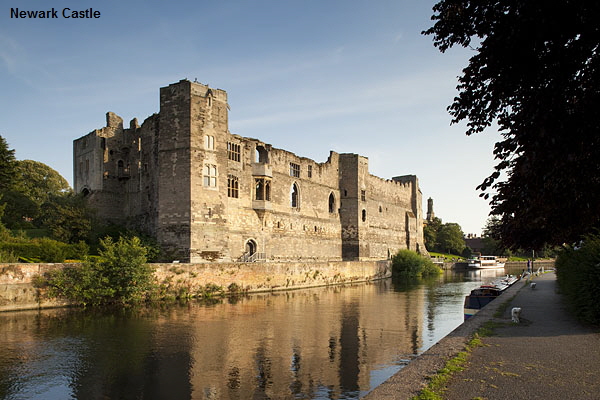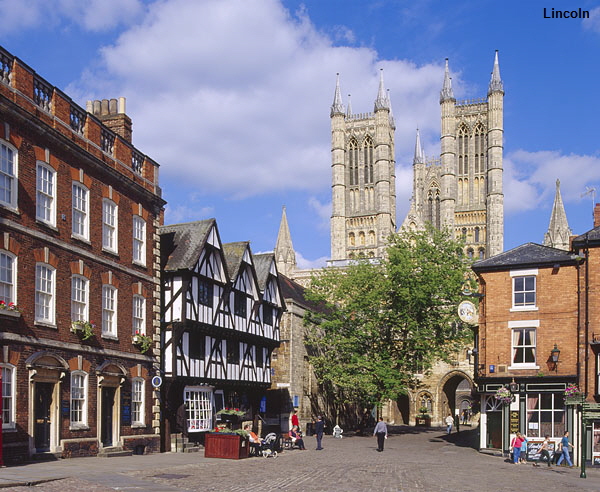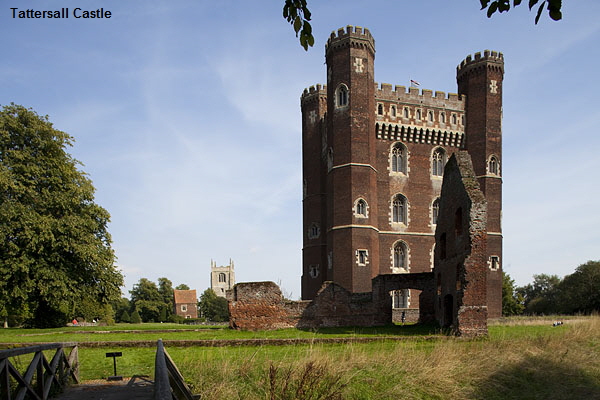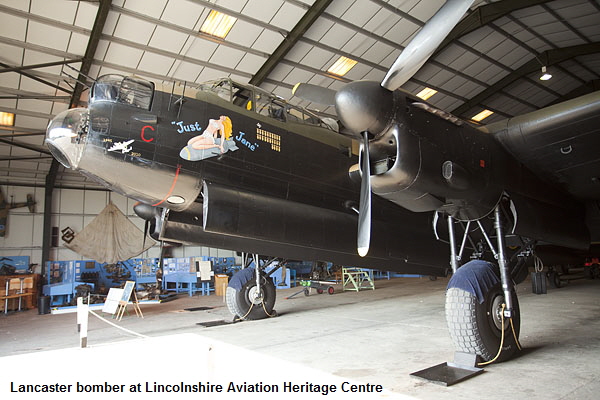|
Bomber County
Craig Roberts touches down in Lincolnshire on a reconnaissance mission to discover why this agricultural area of eastern England was called Bomber County during the war
When planning a tour or trip away, I find it’s always more interesting if you can set a theme or connection to the trip in some way. In the past, this has encompassed castles, stunning gardens, literary and naval connections. It gives the trip a sense of purpose and makes you research a bit more, which I always enjoy doing and of course you get to learn a little bit of history along the way.
The theme for this trip came to me when I decided to make Lincolnshire my next trip in the van. I couldn’t decide which places in the county to visit and whether to just drive up the coast or go for the picturesque southern area. It was through doing some research however, that the term bomber county kept coming up.
Unbeknown to me, Lincolnshire was the bombing county of England during the Second World War and it features more RAF airfields than any other. The county dutifully respects its connections with a variety of museums, memorials and other attractions recalling the history and remembering the airmen and women who lost their lives during the war. This then would become the basis of the tour and I planned the route to take in the best attractions.
I arrived in Newark-on-Trent, a town dominated by its castle. The castle is merely a shell with just its outer walls still standing after it was destroyed during the English Civil War. It dates back to 1123 and was built by Alexander the Magnificent, which is a great name to award yourself!
 |
It’s a really nice town to walk around with some fine old buildings and a lovely market place and Buttermarket inside the Palladian style Town Hall. This is full of quaint shops and stalls, as well as the town museum and art gallery. Visit the Tourist Information Centre on Castle Gate and pick up the trails guides. There’s one on each of the several building styles in the town, including Art Deco, Medieval and timber framed, and Georgian buildings. Unfortunately, a lot of the car parks here have height barriers and only suitable if your camper van is a compact model under 7’9 ft tall. However, there is a small open car park by the castle and also one by the station, or the local Waitrose supermarket seems to be free for parking in the town. The town is actually on the border of Nottinghamshire, but I was drawn to the area because of the nearby air museum, which fitted in nicely with the theme of the tour.
The museum is on the north east side of the town, located on the former World War Two airfield at Winthorpe and well signposted from the town. Very little remains of the original wartime buildings and the original runway is no longer fit for use.Although the museum is more about modern aircraft and not directly linked to the bomber county attractions, it’s still worth visiting. The two main hangars are bustling with full size aircraft from recent years, including the Harrier Jump Jet and Westland Wessex helicopter. Outside are more era defining aircraft including the Vulcan and Shakleton Bombers.
A visit to the village of Skellingthorpe, finds the first memorials on the trip. The two here are dedicated to the airmen and ground crew who served at RAF Skellingthorpe. A small Heritage Room can be found in the car park off Lincoln Road, which gives account of 50 and 61 Squadrons who were based here.
Make a point of visiting the city of Lincoln on your trip, as it’s a beautiful city.The cathedral here is one of my favourites and as part of my previous themed tours, I once visited the most significant cathedrals in the country and fell in love with Lincoln, especially the interior. An evening rendition by the choir, whilst looking up to the cloisters is a magical moment that will stay with me.
 |
The castle is also worth a visit and the castle walls are a great place to get a view of the cathedral above street level. It was built by William the Conqueror and houses the Lincoln Magna Carta, which dates back to 1215. Lincoln holds a Christmas market in December and it’s worth making a visit here to wander round the stalls at this time of the year with the cathedral standing as a backdrop. I found good on street parking by the Lindum Sports Ground on Wragby Road, after I discovered the new car park at the waterfront was annoyingly a multi-story job. The Lindum alternative is still only a short walk from the cathedral, so ideal.
Just north of the city centre is Scampton, the home of the red arrows. There is a small museum here which you can visit for free, but by appointment only, so it’s a case of phoning before hand to arrange a visit if it fits into your schedule. The museum shows the bases most famous squadron 617, better known as the Dam Busters. The red arrows have been here since 2000 and you may catch sight of them, if they happen to be training on your trip. Unfortunately, the website hasn’t been updated to say when they are next due to fly, so it’s pot luck really. If visiting the airfield, stop off at the Dambusters Inn in the village. Sadly, only an appeal because of its name, as most of the memorabilia inside belonged to a previous landlord, who took his collection with him.
To the east of Lincoln city is the small village of Bardney and here you will find a memorial to IX squadron who flew from Honnington, Waddington and from Barndey between 1943-45. The propeller on the memorial is actually from a Lancaster bomber.
The next museum worth visiting is Metheringham Airfield Visitor Centre. This small museum is dedicated to the airmen and women of 106 Bomber Squadron. It includes a recently restored original gymnasium and contains artefacts and displays, but only open on Wednesdays and weekends.
From here it’s onto Woodhall Spa. It’s these roads to the east of Lincoln that are typical of the area. Long flat roads with no real view to speak of, but then after a long straight you are confronted with a tight hairpin bend, which can catch you out if you are being too hasty.
Woodhall Spa has its own memorial, larger in size this time, that celebrates the famous Dambusters, whos Officer’s Mess was Petworth House on the edge of the village. This is now a hotel and a nice one too, with delightful gardens attached. You can go and see the Squadron Bar where the men drank and this is full of pictures and memorabilia. The main memorial stands as a memory to the heroes and lists the complete names of those that lost their lives.
Leave Woodhall Spa on the B1192 and you’ll pass Thorpe Camp, which is another small visitor centre dedicated to the squadrons based at RAF Woodhall Spa. A Lightning jet stands at the entrance and the exhibits are housed in small municipal huts. The out of shape Lancaster propeller here at the entrance was recovered from The Wash. Like Metheringham, it’s only open on certain days of the week, but worth a visit if you come on the right day.
I broke off the Bomber trail for a bit, for history from a different era, to visit Tattersall for the castle. This National Trust owned and was built by Ralph Cromwell, Lord Treasurer of England, one of the most powerful men in the country in the 15th century. You can explore the six floors of this redbrick medieval castle. There are some great views from the top revealing the Lincolnshire countryside beyond. As you walk around the interior, look out for the machicolation holes, more commonly found on French castles, and quite rare on English ones, which where used to drop missiles on would be attackers.
 |
It’s only a short drive from here to RAF Coningsby, home to the Battle of Britain Memorial Flight Visitor Centre. From here they operate a Lancaster, five spitfires, two Hurricanes and a Dakota. Now that is some dream aircraft garage. The museum is small, but there is a guided tour of the hangar and of course this helps you learn as much as possible from your visit. The tour is by guide only because this is a working air base and this means that every couple of minutes, modern jets are landing and taking off at great speed, creating one hell of a show. The tour of the hangar was led by a knowledgeable and enthusiastic volunteer (many of whom are veterans), who gave us the full history of the ‘City of Lincoln’ Lancaster Bomber that was out on the taxi way. This is one of only two in the world today that are still airworthy, so if you ever see one at an airshow, it is probably this one.
Willow Holt Campsite makes a good stopover once you reach this side of the county, with its wonderful lakeside location. In fact it’s very similar to the one at Smeaton’s Lakes at Newark, which also features a lake and therefore ideal for a spot of fishing if that’s your bag. All the campsites on this tour are real gems and I couldn’t find a bad one amongst them. They all have an air or relaxation to them and I usually find on a trip that you get one bad egg, but not here, so top marks to Lincolnshire on that one.
The Lincolnshire Aviation Heritage Centre at East Kirkby can easily be seen as the highlight of the tour. The museum and heritage centre here is the largest of those based on ex-military airfields and it’s home to another rare Avro Lancaster Bomber. This family run museum, is the only airfield in the country recreated to its original design on the site of an original WW2 airfield. This gives the museum real atmosphere and the realism really brings home what it was like to be a pilot based from this airfield. You can wonder around the original control tower and also see the original Barnes Wallis Bouncing Bomb. Also, in the windsock, spot the bullet hole caused by an attack from a German Night Fighter.
 |
Throughout the year the ‘Just Jane’ Lancaster performs taxi runs, for which you can pre-book your ride if you so desire. Unfortunately it doesn’t take off, as it isn’t airworthy like the Coningsby one (although, the dream is apparently to get it to this level again), but you still get a sense of the power and nostalgia of this historic aircraft. Described as a VIP Experience, you can imagine these rides are not cheap and have to be booked well in advance. For those with less deep pockets the experience of simply watching the taxi runs is still an event in itself. The museum also has dogfights and flying displays throughout the year as well as playing host to a full airshow in August and this may be worth planning a visit for.
Being so close to the coast, I travelled onto Skegness to take in the sea air. ‘Skeggy’ is famous for the jolly fisherman character that was used to advertise the town in the 50’s. ‘Skegness is Bracing’ was the slogan used and it certainly was on my visit. The statue of the fisherman stands in the Market Square promenade. I was reliably informed by an elderly resident, that the bracing term used in the advert actually refers to exciting rather than cold and Skegness certainly is a fun seaside resort. Therefore, as you would expect, there is lots of entertainment here including a large funfair and a seal sanctuary, both of which would be a hit with the kids.
Those are the main attractions to see in the area, but there are many more to explore including memorials at Wickenby, Waddington and Binbrook. There is also a disused airfield at RAF Bardney and more attractions and displays at RAF Cranwell and RAF Digby. So, this area can be discovered in many ways, depending on whether you want a brief history lesson or if you want to get the full story of the WWII connections and want to explore even the most deserted airfield and aircraft remains.
If like me and you like to make your excursions a bit more interesting and informative then look no further than this fascinating trail of Bomber County.
All images and text copyright © Craig Roberts 2011
|